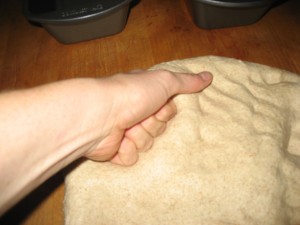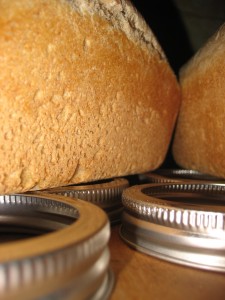Yes You Can (Part III)
Oh my god. You’re still in Night One. Your dough has been rising for 22 days. Assuming, that is, you rushed out to the store and stocked your pantry and then dove into the first night of a two-day slow rise when I first posted.
Forgive me for leaving you so long in dough rising suspense.
Night Two: Nap and Bake
Your second evening of work will require your presence for at least two hours, and your active attention for about 30 minutes.
When you get home from work, the first thing you should do (after you let the dog out) is punch down the gigantic puff that’s become your dough. Literally, use your fist and smash down the double sized-dough bubble in the bowl to release all the gasses produced by your yeast. Don’t be sad—it’s normal to have punch anxiety. helloooo dough puffGrab and grease two medium sized loaf pans with either butter or olive oil.
helloooo dough puffGrab and grease two medium sized loaf pans with either butter or olive oil.
Dump the dough onto the counter and knead it for about a minute. Lil’ KneadThen slice it in two.
Lil’ KneadThen slice it in two. double doughShape each half into a rough rectangular shape about the same length as your loaf pan. Peel the rectangle off the counter and fold it lengthwise like a taco, pinching together the seam.
double doughShape each half into a rough rectangular shape about the same length as your loaf pan. Peel the rectangle off the counter and fold it lengthwise like a taco, pinching together the seam. taco timePlace that sealed taco seam-side down in the greased loaf pan. Repeat with the other dough rectangle.
taco timePlace that sealed taco seam-side down in the greased loaf pan. Repeat with the other dough rectangle. ready for 2nd rise, or more importantly, your 1.5 hour breakCover with a towel or plastic wrap and stick the loaf pans in the cool oven, keeping the oven off. The pilot (if you have a gas oven) creates the perfect temp for the final rise. My house is chilly in the winter and the open countertop doesn’t work well for the final rise. If your house is not gas powered, turn the oven on, let it reach 200° F and then turn it off. Stick the loaves in after the oven has been off for at least 10 minutes.
ready for 2nd rise, or more importantly, your 1.5 hour breakCover with a towel or plastic wrap and stick the loaf pans in the cool oven, keeping the oven off. The pilot (if you have a gas oven) creates the perfect temp for the final rise. My house is chilly in the winter and the open countertop doesn’t work well for the final rise. If your house is not gas powered, turn the oven on, let it reach 200° F and then turn it off. Stick the loaves in after the oven has been off for at least 10 minutes. break time in bread landMake dinner, take a nap, check your Facebook page, do whatever…Your bread needs this time to make its final rise in preparation for baking.
break time in bread landMake dinner, take a nap, check your Facebook page, do whatever…Your bread needs this time to make its final rise in preparation for baking.
After your break, the loaves will have doubled in their pans. dough poking up through the cello wrapTake them out of the oven, if that’s where they’ve been rising, and preheat the oven to 450°. Bake for 10 minutes on 450° and then reduce heat to 350° and bake for about another 20-30 minutes. All ovens vary in temperature and heating patterns, so rotating your loaf pans to various places in your oven will ensure the loaves are cooked uniformly.
dough poking up through the cello wrapTake them out of the oven, if that’s where they’ve been rising, and preheat the oven to 450°. Bake for 10 minutes on 450° and then reduce heat to 350° and bake for about another 20-30 minutes. All ovens vary in temperature and heating patterns, so rotating your loaf pans to various places in your oven will ensure the loaves are cooked uniformly.
After 20 minutes at 350°, I stick my thermometer in the corner of the loaf just to be sure my oven hasn’t gone wild. Take the loaves out when the thermometer reads 200-205° internally. Drop your loaves out of the pans immediately and place them to cool on the rack. Note the hollow sound when you tap the bottom of the loaves; this is another sign of doneness. done!First Timin’ Tips
done!First Timin’ Tips
Baking a loaf of bread from scratch may be a first and a last for you. It’s important to make it special and not stressful. Here are a few tips and words of advice for you keep in mind:
1. Though any day will do in the future; give yourself some room on the first attempt. Select a day where you’re not in a time crunch, perhaps a lazy weekend afternoon?
2. Call at least one girlfriend to join you. Said girlfriend does not actually have to be involved in the baking process, but you need a warm body in the room. Gal pal may be substituted for your spouse or boyfriend/girlfriend. My good friend came over, made tea, and sat at my kitchen table keeping me apprised of all the important things I needed to know going on in her life—from celebrities she sees in her neighborhood to the blue dress she just couldn’t seem to find. She was invaluable in helping me not take myself so seriously (and keeping flour out of my computer keyboard) as I scrupulously followed a recipe.
3. Pick a recipe and stock your arsenal in advance. The internet is a great source for recipes and identifying the 500 different ways you might consider making the same exact thing.
4. Recipes are meant to be broken. I’m recipe-phobic; give me a set of instructions and I’ll start devising a way of altering or avoiding them. Give yourself some room to interpret one person’s method into one that works well for you.
5. Clean and sanitize your countertop before getting started, so you don’t have to worry while you’re elbow deep in flour and transitioning from mixing to kneading.
6. Don’t try to knead your dough on a cutting board, no matter the size or material. Unless your board has industrial strength suction cups, you’ll end up frustrated.
7. Pretty apron (optional)
8. Make tea (or margaritas) to make it official; a drink of some sort helps you remember that you are having fun.
9. Don’t cut the bread until it has cooled completely (approx. 40 minutes) since it is still developing flavor in the cooling process.





 Monday, November 30, 2009 at 7:15PM
Monday, November 30, 2009 at 7:15PM

Reader Comments (1)
I will definitely be trying some of your recipes. I am also glad to hear that GF Mommy is alive and well, although, it's now been over 2yrs since she has posted anything.